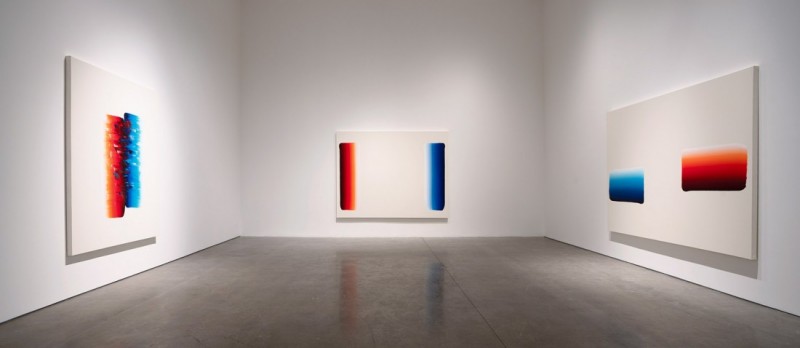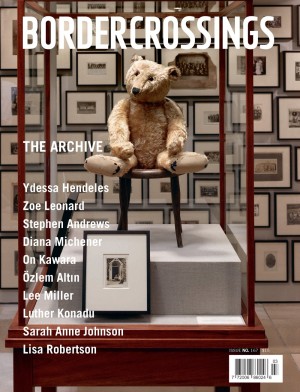Lee Ufan
Lee Ufan is associated with two of the most important currents in the Asian art of the last half-century: Mono-ha or the “school of things” in Japan (as a participant and theorist); and (as a promoter and fellow traveller) Dansaekhwa or Korean monochrome painting—a “movement” that was recognized as such only in retrospect. But as with most outstanding artists, Lee has mostly gone his own way, and the only movement that’s been entirely relevant to his work has been the movement of his own thought. Not only a painter and sculptor but also a critic and theorist of art—his collection of writings in English translation, The Art of Encounter, 2008, is well worth seeking out—Lee was born in Korea in 1936, and in 1956 went to Japan to study philosophy (with a particular interest in phenomenology). He’s remained there since, though later spending part of his time in France as well.

Lee Ufan, installation view, “Lee Ufan,” 2018, Pace Gallery, NY. Photo: Mark Waldhauser. © 2018 Artists Rights Society (ARS)/ADAGP, Paris. All images courtesy Pace Gallery, NY.
Lee’s best-known works are probably the sculptures he titles “Relatum” (1968–present) and the paintings called “Dialogue,” which he has been making since 2005. The sculptures are made by juxtaposing steel plates and boulders—a man-made, industrial material with a natural object, something formed according to human intentions and in indifference to it. Since the objects are not affixed to each other, their arrangement is clearly temporary; we are led to wonder about the possible relationship between human endeavour and what the philosopher Quentin Meillassoux calls le grand dehor (“the great outdoors”). The paintings also present simple encounters, but of a different kind: what appears to be one or more strangely large, squarish brush strokes, normally in shades of grey, on a bare canvas. So in this case the “dialogue” is between another industrial product, the machine-made canvas, “a neutral field of expression linked to the walls and surrounding environment,” as Lee has said, and a manual gesture, not overtly expressive or individualized, yet emphatically specific. In fact, what appear as single brush strokes are reiterated passes of the same brush over the same spot on the canvas, building up a considerable impasto. These massive brush marks are highly physical—Lee mixes ground stone into the paint to give it more body—and not exactly monochromatic, since there are gradations of tone from light to dark across each stroke. As I remarked when reviewing a show of Lee’s in London 10 years ago, the subtle shading almost looks as if it had been spray-painted across the surface of the paint. In other words, the paintings’ seeming minimalism is counterpointed by an unexpected illusionistic aspect.

Lee Ufan, Dialogue , 2018, acrylic on canvas, 291 x 218 x 3.8 cm. © 2018 Artists Rights Society (ARS)/ADAGP, Paris.
The 13 new paintings (including a standing four-panelled screen) Lee exhibited in his New York show last fall were all titled “Dialogue,” but anyone familiar with the series so far—or with Lee’s previous work in general—was bound to find them surprising. Instead of the familiar grey paint on white canvas (in harmony with the grey of the steel and stones used in his sculpture), these new works, made between 2016 and 2018, were outrageously colourful. It might seem an exaggeration to use that word of canvases bearing just one or two colours each, in most cases either blue or reddish orange, and those on a much larger white ground (as in the previous “Dialogue” works). But the sensation of colour—and of the brightness of the colour—in these paintings is intensified by the way, in most of them, each coloured brush stroke bears a tonal range from searing white to near black, with the pure colour itself in the middle of the brush stroke seeming to emerge as an epiphenomenon of some intense light.
Even more surprisingly, in several of the new paintings, the one or two big brush marks have been gone over with a multitude of fluttering little strokes of many distinct hues. Thus, in one vertical Dialogue dated 2017, a vertical, almost columnar red stroke on the left blends into a similar but slightly higher blue area on the right, so that the energetic horizontal rows of small comma-shaped brush marks done across them effectively mix the two colours toward the work’s centre. And then one realizes that the mixing is not entirely the result of the small strokes crossing the two big ones and carrying paint across—sometimes the artist has clearly added new quanta of one of his colours that had to have come from the palette and not from the other side of the painting. Which is to say, this is not process painting—it’s simply painting, without qualification, and if one were to look at these passages in close-up and forget about scale, they might not look so different from some subtly worked transition in a still life by Morandi, or in the depiction of a rich fabric worn by a figure in a scene by Delacroix. Like Morandi’s, Lee’s works have always been overtly austere yet secretly full of sensuality; suddenly now they are more like Delacroix’s, full of brilliant light and energy, yet ultimately more melancholy and contemplative than at first they seem.
“Lee Ufan” was exhibited at Pace Gallery, New York, from September 14 to October 13, 2018.
Barry Schwabsky’s recent books are The Perpetual Guest: Art in the Unfinished Present (Verso, 2016) and Heretics of Language (Black Square Editions, 2017). He is editing a new series of monographs on contemporary painters for the British publisher Lund Humphries.

